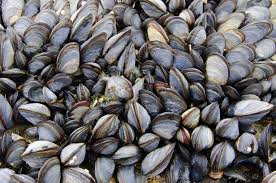 They’re strong, flexible and tough – mussels have proved they’ve got muscle. Recently they’ve inspired researchers to create a new plastic which could potentially heal itself.
They’re strong, flexible and tough – mussels have proved they’ve got muscle. Recently they’ve inspired researchers to create a new plastic which could potentially heal itself.
Plastics are made of polymers – long, repetitive chains of atoms which can stretch and then relax back to their original shape. Designing a polymer is a trade-off between strength and flexibility. Most polymers are made by binding separate chains together to make an orderly, covalently-bonded mesh. These polymers are stiff but will break if they’re pulled too hard.
Other kinds of polymers – used in tire rubber, wetsuits and Lycra gym gear – use weaker bonds between positive and negative charges to make a mesh which is looser and more flexible. These opposite charges can bond with each other again after being pulled apart, so after breaking the polymer can heal itself and return to its original shape.
Mussels craftily dabble in both kinds. A mix of natural polymers in their byssal threads helps them to cling to rocks despite constant tugging from the sea.
Ever willing to learn from nature, researchers have mimicked the mussels’ tactics by adding charged chemical groups to covalently-bonded gels. When the negative and positive charges interact, they make extra links which toughen up the gel.
It’s perfect, except for one major problem: so far, these polymers have only been made in water, where they expand to absorb the liquid. This is bad news for the stretchy polymers, because they can’t expand much more without breaking. Water also keeps the charged groups apart, resulting in weaker interactions.
Megan Valentine, a materials scientist at the University of California, has finally overcome this problem. Starting with a gel polymer called PEG held together by covalent bonds, her team added negatively charged catechol groups (the same as those found in the mussels’ byssal threads) to the individual polymer strands. This is nothing new, but Valentine’s clever trick was to cover the catechols with a cap to protect them from reacting with air or water. Right before adding in positively charged iron, the researchers used acid to get rid of the caps, leaving them free to make links with the iron.
This technique utterly transformed the final dry product from a gel to a tough, flexible plastic. It’s extremely rare for a single extra step to change a polymer so dramatically, and this doesn’t only work on PEG – theoretically, it could be applied to many other polymers, a possibility which Valentine and her team are already working on.
For now, the strong new material will be put to work. The iron-catechol network doesn’t store energy when stretched, so instead of bouncing back like a rubber band it slowly recovers like memory foam. This makes it ideal for coating such as mobile phone cases, which need to absorb the energy of impact when dropped. It could also be used to create tough biomaterials such as artificial robot tendons.
If you thought the only thing mussels are good for is smothering in white wine and garlic, remember these tenacious rock-huggers have a lot more to offer us.